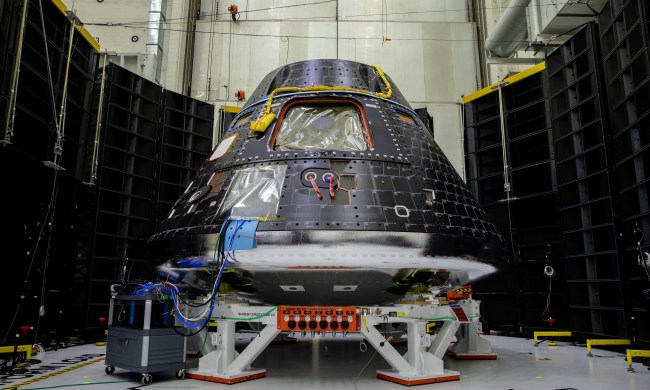NASA’s next-generation Space Launch System (SLS) rocket has exited the Kennedy Space Center’s Vehicle Assembly Building and is now inching its way toward the launchpad for the first time.
Once it reaches Pad 39B, NASA’s most powerful rocket to date will undergo several test procedures ahead of its first lunar mission in May as part of the Artemis program.
The SLS rocket, topped with the Orion spacecraft, emerged from the assembly building at just after 5:45 p.m ET (2:45 p.m. PT) on Thursday, March 17, carried by NASA’s workhorse Crawler Transporter-2 vehicle.
With a top speed of only 1 mph, and a few scheduled stops along the way to ensure everything is as it should be, the journey to the launchpad is expected to take up to 12 hours, so it won’t be until early Friday that we’ll get our first glimpse of the 332-feet (98.1-meter) SLS rocket on Pad 39B.
The Kennedy Space Center’s Twitter account posted photos (below) of the early stages of the rocket’s journey, while a live feed of the site is also running, though the location is currently shrouded in darkness.
We are going. 🚀 pic.twitter.com/JjAST7GQae
— NASA's Kennedy Space Center (@NASAKennedy) March 17, 2022
For the first time, the fully assembled rocket and spacecraft for the #Artemis I mission has left the Vehicle Assembly Building.
The team is in a planned pause to retract the Crew Access Arm. Once complete, the team will continue to the pad: https://t.co/opA74dw6FT pic.twitter.com/0ZgBQuTzNx
— NASA's Kennedy Space Center (@NASAKennedy) March 17, 2022
The Space Launch System and @NASA_Orion continue to roll into the night. They are planned to reach the pad around dawn. pic.twitter.com/Uz2mwrXE22
— NASA_SLS (@NASA_SLS) March 18, 2022
This time-lapse from Boeing Space shows the rocket disappearing into the night.
Goodnight, Moon!
The 322-foot-tall @NASA_SLS rocket for #Artemis I will arrive at Launch Pad 39B soon. pic.twitter.com/RKEdC4lF9i— Boeing Space (@BoeingSpace) March 18, 2022
Various dignitaries attended a special event at the Kennedy Space Center in Florida to mark the rocket’s first trip to the launchpad.
In a speech at the site, NASA chief Bill Nelson said, “The Artemis generation is preparing to reach new frontiers. This generation will return astronauts to the moon, and this time we will land the first woman and the first person of color on the surface to conduct groundbreaking science.”
He continued: “NASA’s Artemis program will pave the way for humanity’s giant leap, future missions to Mars. There is no doubt that we are in a golden era of human space exploration, discovery, and ingenuity in space, and it all begins with Artemis I.
“When this monster rocket lifts off, it will carry all of our greatest hopes in the heavens. Every single person who dreams of discoveries will see many more in our lifetime.”
The Artemis I mission will involve SLS sending Orion on an uncrewed flyaround of the moon to check that the rocket and spacecraft function correctly. Artemis II will repeat the mission, but with a crew on board, while Artemis III, which should take place before the end of this decade, will put humans on the lunar surface for the first time in five decades.


